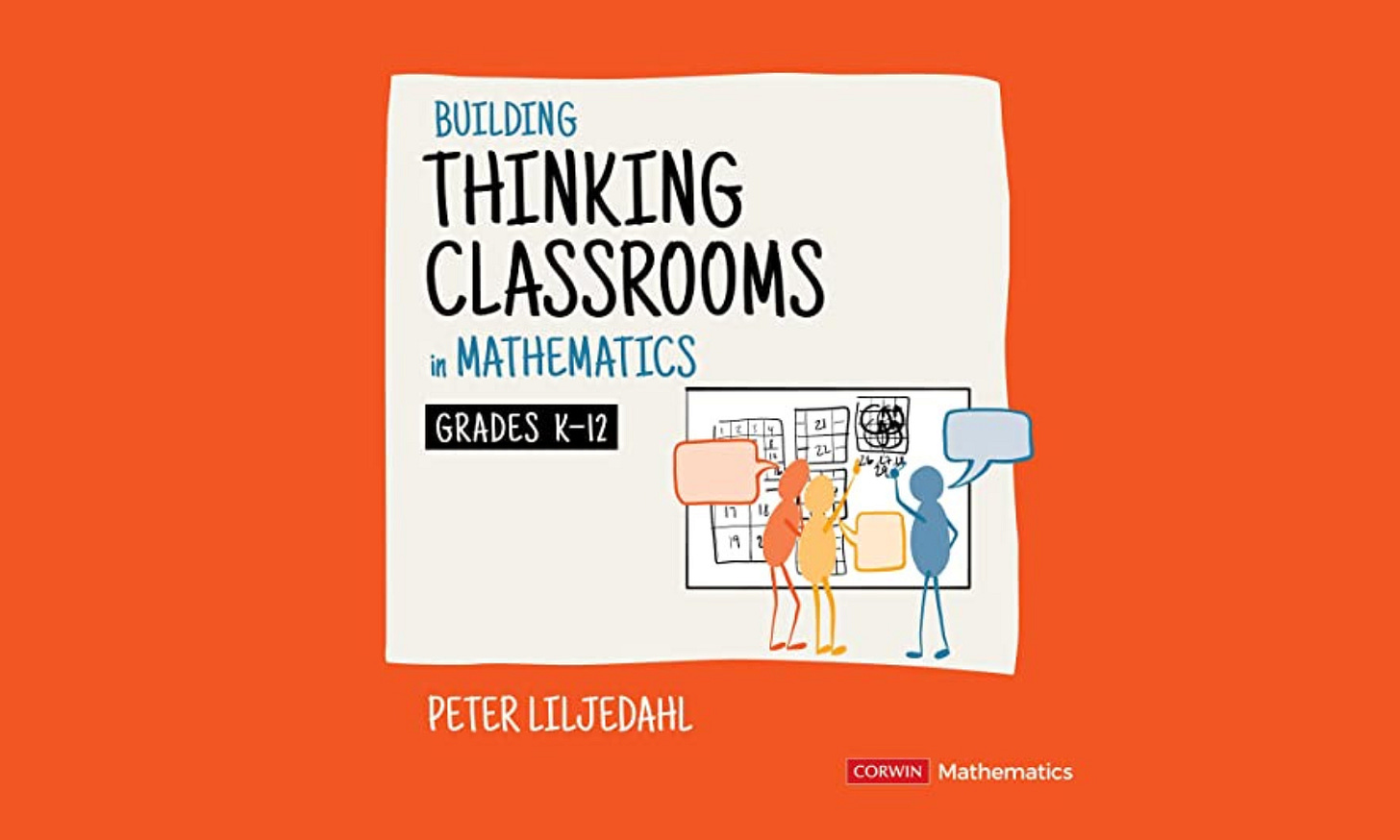Whatever Happened to "Building Thinking Classrooms"?
An out-of-the-box teaching method went viral for all the right reasons, and then vanished. Why?
If you walk into a classroom and see a mass of students seated in combo desks facing the front of the room, those students probably aren’t learning.
At the very least, they aren’t thinking, says Peter Liljedahl, author of Building Thinking Classrooms in Mathematics: 14 Teaching Practices for Enhancing Learning (often referred to as BTC).
Released in 2020, the book, which offers strategies for redesigning classrooms and synchronous activities to promote thinking, gained a cult following among K-12 math teachers. But it wasn’t until 2022 that Liljedahl’s disruptive frameworks went viral on TikTok and YouTube EduTok. Since the book’s launch, hundreds of educators have documented their approach to building thinking classrooms. Below is one thorough example:
 Tiktok failed to load.
Tiktok failed to load.Enable 3rd party cookies or use another browser
2023 marked the height of BTC’s popularity, with features on the EdSurge Podcast, The Cult of Pedagogy Podcast, and The Main Idea.
The book has sold over 200,000 copies to date. But why did it come and go so swiftly? Why hasn’t it endured like recent pedagogy titles like Teach Students How to Learn and We Want to Do More Than Survive, both of which have reached similar levels of virality?
Why Do We Need Thinking Classrooms?
My opening statement about students not learning or thinking in traditional classrooms isn’t completely true. Surely, they are thinking, but getting them to think critically toward the designated learning outcomes in a traditional classroom setup can be challenging.
In Peter’s appearance on the Ed Surge Podcast, he warns educators not to be fooled by students’ performative talents. He refers to this skill as “studenting”, a term coined by Gary Fenstermacher, where students perform behaviors commonly associated with thinking in the interest of achievement rather than learning.
These behaviors include pensively staring off into the distance to indicate deep thought, vigorously copying content from the board into their written notes, and mimicking teacher-modeled processes that test students’ short-term memory instead of their creative problem-solving.
Liljedahl observed plenty of studenting in his 2016 study, where he observed 40 math classrooms in 40 distinct and diverse K-12 school settings across Canada. He intentionally sought out “good teachers”, those whom students, parents, and fellow teachers regarded as highly effective. What he found was shocking: even in the “best” classrooms, students weren’t thinking.
How to Build A Thinking Classroom
According to Liljedahl, thinking is what we do when we don’t know what to do. To build a thinking classroom, both the room and the activities done within it must empower students to problem solve in a way they’ve never seen or done before.
His 2016 paper, which he says served as the foundation for BTC, outlines nine elements of mathematics teaching that determine whether a classroom is a thinking or non-thinking classroom:
The type of tasks used and when and how they are used
The way in which tasks are given to students
How groups are formed, both in general and when students work on tasks
Student workspace while they work on tasks
Room organization, both in general and when students work on tasks
How questions are answered when students are working on tasks
The ways in which hints and extensions are used, while students work on tasks
When and how a teacher levels their classroom during or after tasks
Assessment, both in general and when students work on task
I used insights shared in his 2023 appearance on the EdSurge podcast, along with videos of teacher implementations on TikTok, to highlight a few common characteristics of thinking classrooms.
Defronting - Educators create a “frontless” classroom by moving the location of the teacher’s desk, orienting students’ desks and chairs so that they’re not all facing the same direction, and using the walls as primary learning spaces.
Frequent, visibly random student grouping - Students are grouped randomly and frequently, to ensure that they experience working with different types of learners and that teacher bias doesn’t influence the selection process.
Work in small groups - Students feed off each other’s ideas, and learn about different idea generation processes. Groups of 3 generally work best.
Getting stuck is the goal - The instructor plans for students to get stuck, and asks them to use their given resources, past experiences, other groups’ suggestions, and rare hints from the instructor to get them “unstuck.”
Vertical, non-permanent thinking spaces - students should be away from their desks and chairs and equally contributing to a “wipeboard”, or a vertical dry erase board
Focus on processes, not products - Ask students about how and why they made decisions, not whether the product of their decisions—or even the decisions themselves—were right or not.
Thinking Classrooms, Or Sinking Classrooms?
BTC has its skeptics. Many claim that Liljedahl’s suggestions create “sinking classrooms”, stifling progress for high-achieving math students and leaving the struggling students completely lost. I defer to the math education community for the verdict on whether thinking classrooms are a benefit or detriment to their discipline. Nonetheless, math and non-math educators have dismissed BTC for claims that it’s built on weak evidence.
To explore the evidence further, I’ll first consider what Liljedahl sought to prove. Then, I’ll address whether he proved it, and whether BTC makes unfounded claims. I’ll do so by using NotebookLM to scour his dozens of interviews for claims, and manually sift through his 2016 paper to corroborate his findings. Disclaimer: I have not read the book, but I encourage readers who have to chime in.
Liljedahl’s research aimed to prove that most K-12 students spend most of their classroom time not thinking, and, according to him, this hunch proved to be true. In his appearance on the Ed Surge Podcast in late 2023, he says that 80% of the students he observed spent 80% of their time engaged in non-thinking tasks, while 20% spent only 20% of their time engaged in thinking tasks. These figures were not found in the 2016 study he referenced.
Another curious finding is that teachers told him they didn’t want students to mimic; instead, they wanted them to understand the material and see connections between concepts. But when he talked to the students of these teachers, almost all said their teacher expects them to mimic. Again, this was discussed in interviews, but not addressed in the paper.
It’s fair to scrutinize the strength of Peter’s findings and the validity of his claims, as the latter are littered with conclusive leaps. I couldn’t find a definition for thinking as a cognitive process, nor could I locate concrete examples of what students in a grade school math class should be thinking about. Instead, he outlines what thinking isn’t, which, he argues, consists of three main student behaviors: mimicking (replicating the instructor’s desired behaviors, answers, and through processes), stalling (finding non-disruptive ways to avoid earnest completion toward a learning task, like sharpening a pencil or asking to use the restroom), and slacking (exhibiting disruptive off tasks behaviors to avoid thinking, like cell phone use and distracting other students).
He then argues that, through observation, thinking classrooms prevent students from relying on these avoidant tactics. He’s not proposing evidence-based thinking practices. He’s instead using logical reasoning to support the practices he’s created, which, he argues, prevents mimicking, stalling, and slacking. Paul Bennett’s 2024 piece—and the 2023 Michael Pershan piece it cites, which analyzes Liljedahl’s four published papers related to building thinking classrooms—put BTC under a scorching microscope.
In light of this bendy statistical support, many fear that teachers are blinded by how good thinking classrooms make them and their students feel, rendering them unable to assess the learning outcomes (or lack thereof) they produce.
Where We Go From Here
Aside from what the book claims and aside from what Liljedahl is attempting to do through his work, I believe the existence of Building Thinking Classrooms is a net positive for education at large. Though some are hard pressed to believe that thinking classrooms lead to thinking, thinking classrooms admittedly make it difficult for students to fake their thinking.
On its face, it challenges educators to be more intentional about how they’re asking students to think, and whether their classrooms empower such thinking. Passive learning techniques, like listening to lengthy lectures, aren’t as effective as active learning techniques, a claim supported by UC San Francisco’s meta-analysis of 225 peer-reviewed studies. This understanding alone should keep our attention on Liljedahl’s suggestions. They might not be the end-all-be-all, but they’re an alternative to a thing that we know isn’t working. We shouldn’t shy away from bolstering Liljedahl’s evidence through future studies.
Let’s remind ourselves that everything we do in our classrooms doesn't have to be supported by peer-reviewed studies. The vitriol with which I’ve seen people scrutinize Liljedahl is a bit unwarranted. He’s amassed a global audience for his ideas, and some academics would never admit their resentment toward that. I’ve borrowed teaching strategies from informal communities of practice I’ve been part of, and they’ve been just as effective as the peer-reviewed stuff.
Liljedahl never claimed that the practices would lead to improved academic outcomes, and neither do the authors of many teaching strategies I use. But when I receive my student evaluations at the end of my courses, students say that those practices challenged their thinking, and in many cases, transformed their lives.
When Building Thinking Classrooms went global, it forced conversations about learning design, learning space design, and what it means to foster productive collaboration between students. If we view thinking classrooms with a cross-disciplinary lens, and tie in today’s conversations about AI and threats to eliminate belonging and free speech from classrooms, there are even more questions to answer. We have an opportunity to answer them, if we want.











